Intel Unveils Meteor Lake Architecture: Intel 4 Heralds the Disaggregated Future of Mobile CPUs
by Gavin Bonshor on September 19, 2023 11:35 AM ESTSoC Tile, Part 2: NPU Adds a Physical AI Engine
The last major block on the SoC tile is a full-featured Neural Processing Unit (NPU), a first for Intel's client-focused processors. The NPU brings AI capabilities directly to the chip and is compatible with standardized program interfaces like OpenVINO. The architecture of the NPU itself is multi-engine in nature, which is comprised of two neural compute engines that can either collaborate on a single task or operate independently. This flexibility is crucial for diverse workloads and potentially benefits future workloads that haven't yet been optimized for AI situations or are in the process of being developed. Two primary components of these neural compute engines stand out: the Inference Pipeline and the SHAVE DSP.
The Inference Pipeline is primarily responsible for executing workloads in neural network execution. It minimizes data movement and focuses on fixed-function operations for tasks that require high computational power. The pipeline comprises a sizable array of Multiply Accumulate (MAC) units, an activation function block, and a data conversion block. In essence, the inference pipeline is a dedicated block optimized for ultra-dense matrix math.
The SHAVE DSP, or Streaming Hybrid Architecture Vector Engine, is designed specifically for AI applications and workloads. It has the capability to be pipelined along with the Inference Pipeline and the Direct Memory Access (DMA) engine, thereby enabling parallel computing on the NPU to improve overall performance. The DMA Engine is designed to efficiently manage data movement, contributing to the system's overall performance.
At the heart of device management, the NPU is designed to be fully compatible with Microsoft's new compute driver model, known as MCDM. This isn't merely a feature, but it's an optimized implementation with a strong emphasis on security. The Memory Management Unit (MMU) complements this by offering multi-context isolation and facilitates rapid and power-efficient transitions between different power states and workloads.
As part of building an ecosystem that can capitalize on Intel's NPU, they have been embracing developers with a number of tools. One of these is the open-source OpenVINO toolkit, which supports various models such as TensorFlow, PyTorch, and Caffe. Supported APIs include Windows Machine Learning (WinML), which also includes the DirectML component of the library, the ONNX Runtime accelerator, and OpenVINO.
One example of the capabilities of the NPU was provided through a demo using Audacity during Intel's Tech Tour in Penang, Malaysia. During this live demo, Intel Fellow Tom Peterson, used Audacity to showcase a new plugin called Riffusion. This fed a funky audio track with vocals through Audacity and separated the audio tracks into two, vocals and music. Using the Riffusion plugin to separate the tracks, Tom Peterson was then able to change the style of the music audio track to a dance track.
The Riffusion plugin for Audacity uses Stable Diffusion, which is an open-source AI model that traditionally generates images from text. Riffusion goes one step further by generating images of spectrograms, which can then be converted into audio. We touch on Riffusion and Stable Diffusion because this was Intel's primary showcase of the NPU during Intel's Tech Tour 2023 in Penang, Malaysia.
Although it did require resources from both the compute and graphics tile, everything was brought together by the NPU, which processes multiple elements to spit out an EDM-flavored track featuring the same vocals. An example of how applications pool together the various tiles include those through WinML, which has been part of Microsoft's operating systems since Windows 10, typically runs workloads with the MLAS library through the CPU, while those going through DirectML are utilized by both the CPU and GPU.
Other developers include Microsoft, which uses the capability of the NPU in tandem with the OpenVINO inferencing engine to provide cool features like speech-to-text transcripts of meetings, audio improvements such as suppressing background noise, and even enhancing backgrounds and focusing capabilities. Another big gun using AI and is supported through the NPU is Adobe, which adds a host of features for adopters of Adobe Creative applications use. These features include generative AI capabilities, including photo manipulative techniques in Photoshop such as refining hair, editing elements, and neural filters; there's a lot going on.


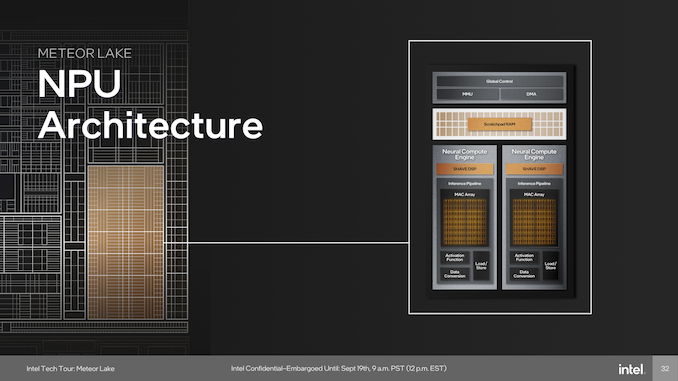
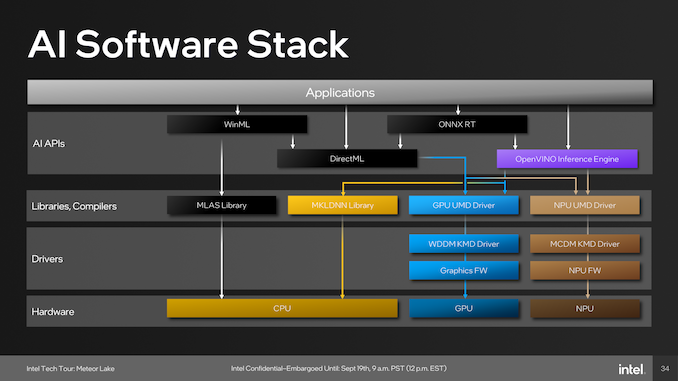
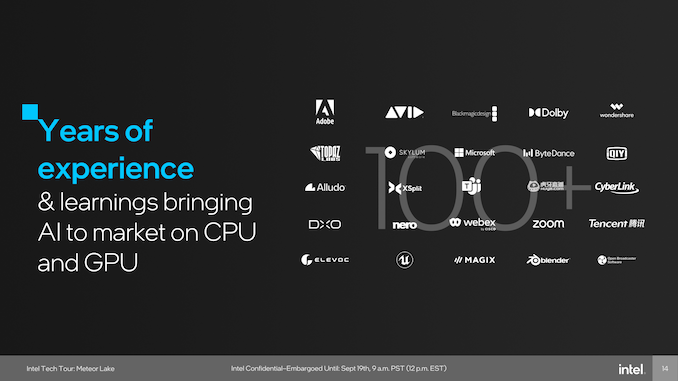

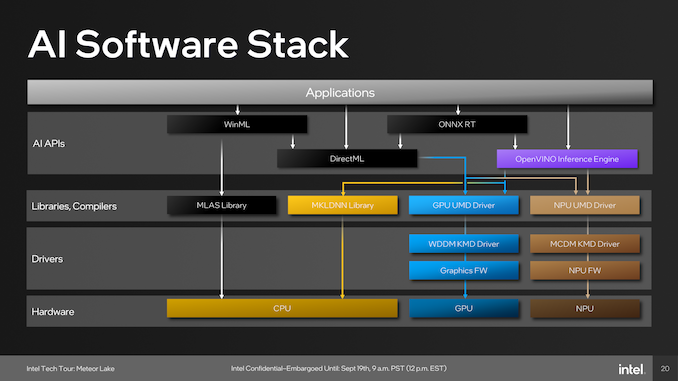
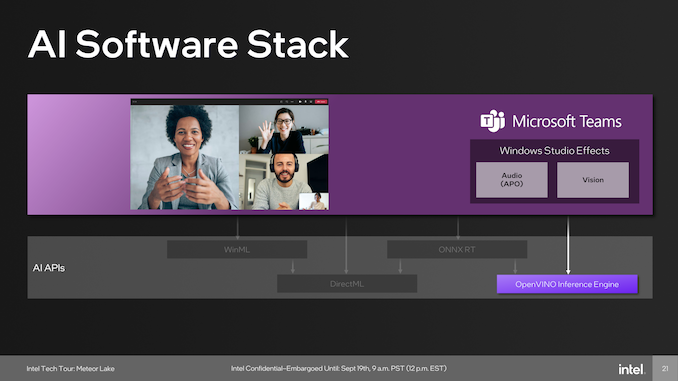








107 Comments
View All Comments
FWhitTrampoline - Wednesday, September 20, 2023 - link
I'm more focused the on eGPU usage for OCuLink so I'm not stating that TB4/USB4 connectivity does not have its usage model for your use case. But pure PCIe is lowest latency for eGPU usage and can be easily adopted by more OEMs than just GPD for their handhelds as that OCuLink will work with any makers' GPUs as long as one is using an OCuLink capable eGPU adapter or enclosure.And ETA Prime has extensively tested OCuLink adapters with plenty of Mini Desktop PCs and even the Steam Deck(M.2 slot is only PCIe 3.0 capable). It's the 64Gbs on any PCIe 4.0/x4 connection(M.2/NVMe or other) that's what good for eGPUs via OCuLink relative to the current bandwidth of TB4/USB4 40Gbs.
Exotica - Wednesday, September 20, 2023 - link
I’ve seen those videos and the performance advantages for EGPUs. But most of the EGPUs in the market use alpine ridge. A chipset known to reserve bandwidth for DP and have less available for PCIe (22 Gbps). Perhaps there may be one or two based on Titan ridge with slightly more pcie bandwidth. It’s hard to say how barlow ridge will perform in terms of the amount of pcie bandwidth made available to peripherals. But a 64 Gbps pcie connection will not saturate the 80 Gbps link so hopefully we can have most of the available 64 Gbps pcie bandwidth. Another problem with occulink is that there’s no power delivery so you need to have a separate wire for power.So Barlow ridge TB5 has the potential to be a one cable solution, power upto 240W, pcie up to 64 Gbps, and it will also tunnel DisplayPort. Occulink is cool. But thunderbolt tunnels more capabilities over the wire.
FWhitTrampoline - Wednesday, September 20, 2023 - link
OCuLink is lower latency as was stated in the earlier posts! And TB4/TB# or USB4/USB# will not be able to beat Pure PCIe connectivity for low latency and latency is the bigger factor for gaming workloads. TB tunneling protocol encapsulation of PCIe/Any other Protocol will add latency the result of having to do the extra encoding/encapsulation and decoding/de-encapsulation steps there and back whereas OCuLink is just unadulterated PCIe passed over an external cable.More Device makers need to be adding OCuLink capability to their systems as that's simple to do and requires no TB#/USB4-V# controller chip to be hung off of MB PCI lanes as the OCuLink port is just passing PCIe signals outside of the device. And TB5/USB4-V2 is more than 64Gbs but that will require more PCIe lanes be attached to the respective TB5/USB4-V2 controller and use more overheard to do that whereas if one has the same numbers of PCIe lanes connected via OCuLink then that's always going to be lower overhead with more available/usable bandwidth and lower latency for OCULink.
Most likely the PCIe lane counts will remain at 4 lanes Max and that will just go from PCIe 4.0 to PCIe 5.0 instead to support TB5 and USB4-V2 bandwidth but whatever PCIe standard utilized OCuLink will always have lower overhead and lower latency than TB/Whatever or USB4/Whatever as with OCuLink that's skipping the extra tunneling protocol steps required.
Plus by extension and with any OCuLink Ports being pure PCIe Protocol Based, that opens up the possibility of OCuLink to TB/USB/Whatever Adapters being utilized for maximum flexibility for other use cases as well.
Exotica - Wednesday, September 20, 2023 - link
OCulink has merit for sure, but again, it is clunky. Unlike thunderbolt, it doesn't tunnel displayport or provide power delivery. It also doesn't support hotplugging. That is why it will most likely remain a niche offering. Also you're saying OcCulink is lower latency, but by how much? Where is the test data to prove that ?And does it really matter? Operating systems can be run directly off of thunderbolt NVME storage, the latency is low enough for a smooth experience. And even if OcCulink is technically faster, a GPU such as a 4080 or 4090 or 7900XTX in a PCIe4x4 or even PCIe5x4 eGPU thunderbolt 5 enclosure will be much faster than the iGPU or even internal graphics. And if the eGPU enclosure is thunderbolt enabled, it can power the laptop or host device and probably act as a dock and provide additional downstream thunderbolt ports and possibly USB as well. Thunderbolt provides flexibility that OcCulink does not. Both standards have merit.
But I have a feeling Thunderbolt 5, if implemented properly in terms of bug-free firmware NVMs from Intel, will gain mass market appeal. The mass market is hungry for the additional bandwidth. AsMedia will probably do extremely well as well with its USB4 and upcoming USB4v2 offerings.
TheinsanegamerN - Thursday, September 21, 2023 - link
Dont waste your time, Trampoline is an OCUlink shill who will ignore any criticism for his beloved zuckertech. The idea that most people dont want to disassemble a laptop to use a dock is totally alien to him.FWhitTrampoline - Thursday, September 21, 2023 - link
LOL, OCuLink's creator PCI-SIG is a not for profit Standards Organization that's responsible for the PCIe standards so it's not like they are any Business Interest with a Fiduciary responsibility to any investors.OCuLink is just a Port/electrical PCIe extension cabling standard that was in fact originally intended to be used in consumer products but Intel, a member of PCI-SIG along with other industry members, had a vested interest in that Intel/Apple co-developed Thunderbolt IP, because of TB controllers and sales of TB controllers related interests.
And TB4/Later and USB4/Later will never have as low latency owing to the fact that any PCIe signalling will have to be intercepted and encapsulated by the TB/USB/Whatever protocol controller in order to be sent down the TB cabling whereas over the OCuLink ports/cabling that's just the PCIe signalling/packets there and no extra delays there related to any extra tunneling protocol encoding/encapsulation and decoding/de-encapsulating steps required.
So OCuLink represents the maximum flexibility as that's the better lowest latency solution for eGPUs being just pure unadulterated PCIe signaling. And because it's just PCIe that opens up the possibility of all sorts of external adapters that take in PCIe and can convert that to Display Port/HDMI/USB/TB/Whatever the end users need because all Motherboard external I/O, for the most part, is in the from of PCIe and OCulink just brings that PCIe directly out of devices via Ports/External cables.
And to be so dogmitacilly opposed to OCulink is the same as being opposed to PCIe! And does any rational person think that that's logical! OCuLink is External PCie and that's all there is to that and it's the lowest latency method to interface with GPUs via any PCIe Slot or externally via an OCuLink connection(PCIe is PCIe).
Give me a Laptop with at least One OCuLink PCIe X4/4.0 port and with that I can interface to an eGPU at 64Gbs bandwidth/lowest latency possible! And there can and will be adapters that can be plugged into that One OCulink port that can do what any other ports on the laptop can do because those ports are all just connected to some MB PCIe lanes in the first place.
Kevin G - Wednesday, September 20, 2023 - link
The main advantage of the TB4 is that the form factor is USB-C which can be configured for various other IO. This is highly desirable in a portable form factor like laptops or tablets. Performance is 'good enough' for external GPU usage. OCuLink maybe faster but doesn't have the flexibility like TB4 over the USB-C connector does. OCuLink has its niche but a mainstream consumer IO solution is not one of them.FWhitTrampoline - Thursday, September 21, 2023 - link
OCuLink is just externally routed PCIe lanes and really there can be one OCuLink port on every laptop specifically for the best and lowest latency eGPU interfacing and even OCuLink to HDMI/Display Port/whatever adapters that can make the OCuLink port into any other port at the end users discretion. So for eGPUs/Enclosures that have OCuLink ports that's 64Gbs/Lowest latency there and for any Legacy TB4/USB only external eGPU devices just get an OCuLink to TB4/USB4 adapter in the interim and live with the lower bandwidth and higher latency.GPD already has a line of Handheld Gaming devices that utilize a dedicated OCuLink port and a portable eGPU that supports both OCUlink interfacing and TB4/USB4 interfacing. And I do hope that GPD Branches out into the regular laptop market as GPD's external portable eGPU works with other makers products and even products that have M.2/NVMe capable slots available via an M.2/NVMe to OCuLink adapter! LOL, only Vested Interests would Object to OCuLink in the consumer market space, specifically those Vested Interests with Business Models that do not like any competition.
TheinsanegamerN - Thursday, September 21, 2023 - link
Because most people dont want to disassemble their laptop to plug in a m.2 adapter, you knucklehead.FWhitTrampoline - Thursday, September 21, 2023 - link
No one is forcing you to do that and for others that's an option, albeit and inconvenient one. But really the adapters are not meant for Laptops in the first place and even for Mini Desktop PCs is not an easy task there but still more manageable that doing that with a laptop. It would just better if there was more Mini Desktop PC OEMs/Laptops OEMs where those OEMs would adopt an OCuLink PCie 4.0/x4 Port for eGPU usage like GPD has done with their line of handheld gaming devices. And with mass adoption of OCuLink there could also be adapters as well to support all the other standards as OCuLink being PCIe based by extension will support that as well.